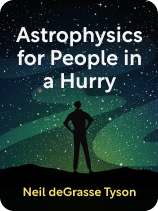

This article is an excerpt from the Shortform book guide to "Astrophysics for People in a Hurry" by Neil de Grasse Tyson. Shortform has the world's best summaries and analyses of books you should be reading.
Like this article? Sign up for a free trial here.
Why should we study astrophysics? What’s dark matter? Are we stardust?
In Astrophysics for People in a Hurry, Neil deGrasse Tyson explains the current state of astrophysics in layman’s terms. He argues for the real-world benefit of looking at ourselves as part of a larger universe.
Keep reading for an overview of this fascinating book.
Astrophysics for People in a Hurry by Neil deGrasse Tyson
Since humans first looked up, we’ve wondered about the sun, the stars, and where we fit in the universal scheme. In the last century, we’ve developed the tools to look farther out into the night sky than our ancestors ever dreamed possible. Our instruments are powerful enough to detect images of the very early universe, yet everything we’ve learned has taught us that our ignorance about the universe still outstrips our knowledge.
That may seem disheartening. But, in Astrophysics for People in a Hurry, Neil deGrasse Tyson suggests that it’s not. Instead, he says it’s exciting to know that there’s so much left to discover about the universe. When we ponder the vastness of the universe and how tiny our place is within it, we realize how trivial our differences are and how much we should value this one world we have. The study of astrophysics is important because it teaches perspective and humility.
Often describing himself as “your personal astrophysicist,” Tyson is a popular science essayist and public speaker, director of Boston’s Hayden Planetarium, and host of the podcast StarTalk. After he starred in two seasons of the science program Cosmos, many people came to see Tyson as famed astronomer Carl Sagan’s successor in the field of popular science education.
(Shortform note: Carl Sagan came to fame as the author and host of the original 1980 book and TV program Cosmos, as well as other works such as The Demon-Haunted World. After Sagan’s death in 1996, Tyson worked with Sagan’s wife, Ann Druyan, and producer Seth MacFarlane of Family Guy fame to create an updated version of the program, which was broadcast in 2014 on FOX and went on to win four Emmys and the Peabody Award for Education.)
Our overview of Astrophysics for People in a Hurry explores Tyson’s arguments as to why the study of astrophysics has value. We’ll detail the assumptions underlying the science and the way that astronomers use the full spectrum of visible and invisible light to study the reaches of space. After that, we’ll explore the three major areas of modern astrophysical study—the origin of the universe, dark matter, and dark energy.
Why Study Astrophysics?
Astrophysics is the branch of astronomy that applies discoveries in chemistry and physics to observations of the stars. Tyson argues that the study of the cosmos provides the human race with a crucial sense of perspective while answering our fundamental drive to understand where we came from.
We humans like to think that we’re special, but Tyson describes how, over and over, science knocks us off whatever pedestal we climb on. Better than any other science, says Tyson, astrophysics teaches humility. In the grand scheme of things, our differences are trivial compared to the things we have in common as a species.
The Basic Assumptions of Science
Science relies on basic, grounding principles and assumptions that have been confirmed through repeated tests and observations. Tyson explains the most fundamental assumptions that lie at the heart of astrophysics—specifically, that science is universal—while also talking about what happens when science meets the unknown and has to be reframed to include new information.
The first general assumption that physicists make is that the same laws of physics apply everywhere in the universe. The rules of chemistry that we confirm in earth-bound labs hold true when we explore other planets.
The second assumption scientists make is that laws of physics don’t change over time. Tyson explains that we can confirm this by looking deeper and deeper into space. With our newest telescopes, we can look billions of years into the past, and we can see that the rules of gravity, chemistry, and relativity were just as true back then as they are in our world today.
Tyson points out that a true law of nature is universal, but that doesn’t mean that we fully understand it. Tyson says there’s plenty of precedent for reevaluating our knowledge in the face of the unknown. Scientists recognize that our best current theories are still close approximations of nature, to be added to and refined as needed.
Scientists regularly debate their hypotheses, but only on the questions that science hasn’t solved. Our confidence in scientific laws that have been confirmed by experiments and repeated observation is very high.
The Full Spectrum of Light
In order to establish physical laws, the scientist’s primary tool is observation. Today we have access to a whole invisible spectrum of light beyond what our eyes can perceive.
The fact there’s such a thing as invisible light was discovered by William Herschel in 1800. Herschel had found infrared light at a frequency below what the eye can detect. Later, many other types of light were discovered, from radio waves, to microwaves, ultraviolet light, x-rays, and gamma rays. All these forms of unseen light differ from each other only in wavelength and frequency, from the low end (radio) to the high (gamma).
The visible light we see every day represents only a tiny sliver of frequencies between the ultraviolet and the infrared. Yet, it took astronomers quite a while to realize these other frequencies were useful tools for looking at the sky. When they did, says Tyson, a whole new universe opened up before them. Taken altogether, our tools to see the sky paint a picture of a universe we’re only just beginning to understand.
The Big Bang
By observing the sky in all available wavelengths, astronomers have worked for the last century to answer one of humanity’s most basic questions: “Where do we come from?” The branch of astrophysics that tackles this subject is the science of cosmology, the study of the origin of the universe itself.
According to the Big Bang theory of cosmology, the universe began as a microscopic point that contained all the matter and energy that would ever exist, as well as all the fundamental forces, such as gravity, that would govern the universe’s development. From that one tiny dot, the universe expanded into the vastness of space that we currently see, 13 billion years later.
Understanding the first few moments of the cosmos is crucial to unlocking one of the biggest riddles science faces. The chief problem in physics today is that we have two working models of how the universe functions that are incompatible with each other. Einstein’s theory of general relativity is great at describing the universe at the macro level, but it doesn’t work at the level of atoms and electrons. Quantum mechanics effectively describes the realm of the very small, but it in no way relates to how physical objects move and interact at the scale that we can see with our eyes.
The importance of the Big Bang to unraveling this mystery is that, in the universe’s first few instants, the realms of relativity and quantum mechanics overlapped. If we can discover how matter, energy, time, and space behaved during the initial moment of inception, Tyson argues that we should be able to resolve the discrepancies between the two theoretical systems. This is the research being done now at the Large Hadron Collider.
The Forces of Nature
In order to unravel the riddles of the Big Bang, relativity, and quantum mechanics, we need to start with the fundamental forces that govern how matter and energy behave. As we currently understand them, there are four: Gravity is exerted by anything with mass. Electromagnetism governs the motion of particles with an electrical charge. The weak nuclear force holds protons and neutrons together in the nucleus of the atom, while the strong nuclear force glues quarks together (the subatomic particles that make up protons and neutrons).
According to Tyson, physicists believe that, in the universe’s primordial state, all four forces were combined into one. Within the universe’s first trillionth of a second, gravity untangled from the others, the strong nuclear force split apart, and then a third force, dubbed “electroweak,” quickly divided into the electromagnetic and weak nuclear forces.
Matter/Antimatter
The universe kept on expanding and cooling. A millionth of a second later, the universe had grown to the size of our solar system. A slight imbalance in the early universe led to there being more matter than antimatter. As the universe’s temperature dropped due to its expansion, so did the energy density needed to create more particles. The matter and antimatter already created continued to annihilate each other, but, because of the slightly higher amount of “normal” matter, that’s what was left when this period was over.
Over the next two minutes, the first atoms condensed out of the primordial chaos. What formed were the two simplest elements—90% are hydrogen and 10% are helium. The universe’s temperature fell to a mere one billion degrees, and all the universe’s matter comprised a sea of hydrogen and helium gas so dense that any light it gave off was quickly reabsorbed. Tyson says that a universal dark age began that would last nearly 400,000 years.
The Cosmic Microwave Background
During the dark age, the universe kept cooling. When at last it fell to 3,000 degrees, it was possible for photons of light to travel without being reabsorbed back into atoms. The universe began to glow. Therefore, from 13 billion light-years away in every direction, we can detect the cosmic background radiation—a snapshot of the universe as it was when the clouds first broke after the Big Bang. Because those ancient photons of light have lost a lot of energy since the time they were emitted, they now come to us in the form of low-frequency microwaves. Hence, this glow from the early universe is commonly referred to as the Cosmic Microwave Background (CMB).
Prior to the microwave background’s discovery, all our theories of the universe’s origin were guesses. Tyson argues that the CMB gives the science of cosmology a solid observational grounding.
Stars and Everything Else
For the next billion years, the densest clumps of gas collapsed under their own gravitational pull until the pressure inside them grew high enough for nuclear fusion to ignite. The first stars began to shine, and the galaxies were born.
The Big Bang gave birth to hydrogen and a fractional amount of helium, but all the other elements we know of today were created in the hearts of burning stars. Every hydrogen atom in the water in our bodies was created by the Big Bang. Every other atom inside us came into being in the heart of a star.
Dark Matter
In addition to expanding what we know about the universe, our deep space observations also reveal that there are major gaps in our understanding of the cosmos. The first of these is the “dark matter” problem—the fact that there appears to be far more gravity in the universe than all the matter we observe can account for. 85% of the gravitational attraction we measure on the cosmic scale seems to come from invisible sources. This “missing mass” problem was first discovered in 1937.
To date, we can tell only what dark matter is not. We don’t know what dark matter is, or even if it’s a form of matter at all. The name “dark matter” is merely a placeholder for something we know is there only because of its effects on what we see. Our best guess is that dark matter consists of an undiscovered type of particle that interacts with others via only gravity, ignoring the other three fundamental forces. Whatever it is, dark matter’s effects show that the so-called “normal” matter we know is only the tip of the universal iceberg.
Dark Energy
In recent decades, astronomers have witnessed a mysterious force they’ve named “dark energy” that’s accelerating the universe’s expansion. No one understands where the energy comes from that drives the galaxies farther apart, but Tyson writes that there’s already a place for it in relativity’s equations—Einstein’s cosmological constant, which astrophysicists now refer to as “dark energy.”
Even more so than dark matter, Tyson reiterates that we don’t have a clue what dark energy is. However, current estimates suggest that dark energy makes up almost 70% of the universe, with dark matter taking up a little more than 25%, and the regular matter and energy we know of comprising a mere 5% of the observable cosmos. Clearly, there’s a lot that we don’t understand.
The Current Frontier
Tyson reminds us that climbing out of ignorance is an adventure and that there will always be something new to discover.

———End of Preview———
Like what you just read? Read the rest of the world's best book summary and analysis of Neil de Grasse Tyson's "Astrophysics for People in a Hurry" at Shortform.
Here's what you'll find in our full Astrophysics for People in a Hurry summary:
- Neil deGrasse Tyson's simple explanations of some of the mysteries of the cosmos
- Why everyone should understand where we fit in the universal scheme
- Why humans need to climb off their pedestals






